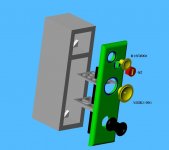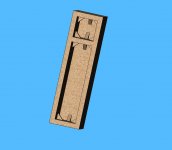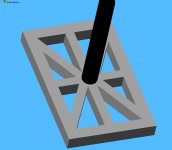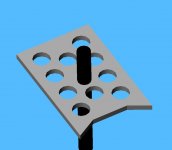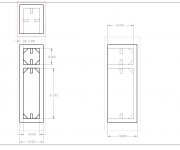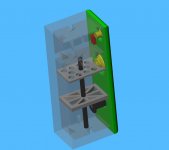Im totally new to the DIY speaker scene, so I thought that I would use a program to help me figure out a nice xover. Im playing doing a MTW design with Seas M15CH-001 (mids) W22EX-001 (woofer) and Fostex FT33RP (tweeter). first off how do you guys think these 3 will go together? I am starting with a front L/R set to get my feet wet but will eventually be building all 7 channels for my HT and maybe a Sub after that. THe program that I found for free is Speaker Workshop, and Im having trouble setting up the parameters for these drivers. It is asking for informantion like the motor strength and voice coil series (L1) and these things are not listed here (http://www.oregondv.com/Seas_Speakers_M15CH-001_E016.htm) or anywhere else that I have found for that matter. are there some fomulas that I could use to find such things? and for the Fostex tweeter there is virtually no info availble that I have found for that other than the basics.
I guess my next question would be, am I on the right track by using this program? is there another you guys use or is it mostly trial and error to build a good box and xover?
I have confidence that once I have a solid design I can manufacture the speaker, I have the tools and the skills to do the phycisal building, its the design that is eating my lunch, as always.
Thanks for any information,
Gavin
I guess my next question would be, am I on the right track by using this program? is there another you guys use or is it mostly trial and error to build a good box and xover?
I have confidence that once I have a solid design I can manufacture the speaker, I have the tools and the skills to do the phycisal building, its the design that is eating my lunch, as always.
Thanks for any information,
Gavin
You re definelty on the right track. There is no other way to properly design and implement a x-over that actually does what it is supposed to, without using a simulation and measuring system. Speaker Workshop seems a bit weird at first but you will soon find out that its a great, and dare to say) easy to use tool. If you cant find some parameters of your drivers, you can measure them with speaker workshop! Which is usualy more accurate than the manufacturer's specs anyway. Do visitClaudio's website it will help you setup/calibrate and use the program very quickly.
You can also try WinISD for easy box modeling.
To desing your x-over you should 1st build the box and then measure the impedance and acoustic response of the drivers (mounted on the box) with speakerworkshop.
The program will use the measured data (including phase!) for crossover simulation. If you calibrate the program properly, and simulate your crossover entering the exact values of the parts you will use (measured with speaker workshop as well ! ) you ll find out that the final result is very close to the simulation (usually the opposite happens..)
. You can use imported data for simulation also, but the result will depend on the data's accuracy (especially for the phase).
You build the box, do measurements, simulate the x-over, build it, and then listen. If you find for example your mids too emphasised, you ll go back to the simulated circuit,
change one or two componens, see on the screen what changes should be made and then modify your crossover and listen the result. You will soon find out that you will
be able to alter the sound of your speakers as you wish. You will also find out that a slight change in a crossover's part can really mess the phase response (which shows that
trial and error is a weak procedure..). You will also find out that even a re-soldering of the part's connections can change the phase a bit, which can't been verified without a measurement.
If you follow the rules for the box (flush mount the drivers, no sharp baffle edges etc) and play much with speakerworkshop for the x-over, you cant fail
You can also try WinISD for easy box modeling.
To desing your x-over you should 1st build the box and then measure the impedance and acoustic response of the drivers (mounted on the box) with speakerworkshop.
The program will use the measured data (including phase!) for crossover simulation. If you calibrate the program properly, and simulate your crossover entering the exact values of the parts you will use (measured with speaker workshop as well ! ) you ll find out that the final result is very close to the simulation (usually the opposite happens..)
. You can use imported data for simulation also, but the result will depend on the data's accuracy (especially for the phase).
You build the box, do measurements, simulate the x-over, build it, and then listen. If you find for example your mids too emphasised, you ll go back to the simulated circuit,
change one or two componens, see on the screen what changes should be made and then modify your crossover and listen the result. You will soon find out that you will
be able to alter the sound of your speakers as you wish. You will also find out that a slight change in a crossover's part can really mess the phase response (which shows that
trial and error is a weak procedure..). You will also find out that even a re-soldering of the part's connections can change the phase a bit, which can't been verified without a measurement.
If you follow the rules for the box (flush mount the drivers, no sharp baffle edges etc) and play much with speakerworkshop for the x-over, you cant fail
thanks for the help, any suggestions on how to start building the box? the only time I will have to move them is to bring them from my shop to my living room and I have a dolly, so I really dont care if they weigh 250 lbs and are triple thick all the way around. also I only need these to be flat to around 60hz because they are for about 75% HT and 25% music I will be running a sub that I either buy or make. do any opf you have suggestions or a link for a box design that I can either use or just get an idea of what I need to do?
Im also going to get David Weems' Great Sound Stereo Speaker Manual and read through it to get a good idea of whats really going on. are there any other GOOD books about speaker design that anyone could suggest?
Im also going to get David Weems' Great Sound Stereo Speaker Manual and read through it to get a good idea of whats really going on. are there any other GOOD books about speaker design that anyone could suggest?
I echo Jomor's endorsement of Claudio's Home Page. In addiition, I put together an Unofficial Manual with the help of several folks including Nelson Wood and Claudio that has not only information about SW but also alot of valuable information about Speaker Building including box design. I am in the process of updating the Manual (target is Dec this year) to correct the offset mistake (I reversed it in the Manual) along with some clarifications and quite a bit more information about speaker building. It also has a lot of useful spreadsheets (which are also being enhanced in the next edition). It can be freely downloaded at http://www.audiodiycentral.com/. It is large so be forewarned!
Testing Loudspeakers by Joseph D'Appolito and Loudspeaker Design Cookbook by Vance Dickason are two wildly referred to references that would also be of interest to you.
There are several educational web sites out there as well.
Enjoy and Good Luck,
Jay
Testing Loudspeakers by Joseph D'Appolito and Loudspeaker Design Cookbook by Vance Dickason are two wildly referred to references that would also be of interest to you.
There are several educational web sites out there as well.
Enjoy and Good Luck,
Jay
I have been working with winISD for box parameters and such like port length. today at work I got the basics of a box build in solidworks, when I get what would be a nice box designed I will post an engineering drawing of it along with the projected response curves to see what you guys think. I am probably going WAY overboard on bracing and thickness of the box but you guys and the books can help me to maximize my design. I ordered the book mentioned previously as well as a new sound card that Claudio's manual mentioned so that I can do driver testing.
Oh one question that I do have is how can I make the frequency on the winISD gragh go out past 500hz to maybe 2500 hz so that I can see my mid's projected curve. tried for a while to figure that out with no luck. I also noticed that there arent any tweeters loaded in the winISD probably because they are all sealed and just need to be flush mounted?
As I run into more questions I will post them, thanks for your time and I will be sure to check out your manual JMB.
Gavin
Oh one question that I do have is how can I make the frequency on the winISD gragh go out past 500hz to maybe 2500 hz so that I can see my mid's projected curve. tried for a while to figure that out with no luck. I also noticed that there arent any tweeters loaded in the winISD probably because they are all sealed and just need to be flush mounted?
As I run into more questions I will post them, thanks for your time and I will be sure to check out your manual JMB.
Gavin
ok, im using winISD to find the parameters for my box, and the curve for the mid that I have mention above is alot better with a sealed enclosure, so i did that. Is it recommended to use a sealed enclosure for the mid and vented for the woofer?
next im trying to make the vented enclosure for the woofer also mentioned above and im using a 4inch port (diameter) and the volume of the box I have design. I have the enclosure tuned to 80hz and I see that when using a 4 inch port, the length of the port is dependent on the volume of the enclosure. I have also been told that when figuring the volume of your enclosure that you do NOT add the volume of the port which is protruding into the enclosure. so therefore there must be some kind of relationship between the length of the port (volume) and the enclosure (volume). something like this (volume of enclosure - volume of port) = C*volume of port
where C is some unknown constant that doesnt really matter. am I making this too complicated?
also im using a flared on one end port in winISD, which would be hard to make, so is there a place to buy something like that? a link would be great. I will post a pic of my design tomorrow after I get some feedback on doing this port thing. thanks for your patients everyone. n00b at work here.
Gavin
next im trying to make the vented enclosure for the woofer also mentioned above and im using a 4inch port (diameter) and the volume of the box I have design. I have the enclosure tuned to 80hz and I see that when using a 4 inch port, the length of the port is dependent on the volume of the enclosure. I have also been told that when figuring the volume of your enclosure that you do NOT add the volume of the port which is protruding into the enclosure. so therefore there must be some kind of relationship between the length of the port (volume) and the enclosure (volume). something like this (volume of enclosure - volume of port) = C*volume of port
where C is some unknown constant that doesnt really matter. am I making this too complicated?
also im using a flared on one end port in winISD, which would be hard to make, so is there a place to buy something like that? a link would be great. I will post a pic of my design tomorrow after I get some feedback on doing this port thing. thanks for your patients everyone. n00b at work here.
Gavin
Originally posted by Gavin_mi am I making this too complicated?[/B]
Of course you are. We all do this. It's normal.
Do you mean protruding "from" the enclosure as in it won't fit? 4" seems pretty large. The bigger the port diameter the longer it has to be. What about 2" or 3"?
Have you purchased these drivers yet? If the Fostex data is hard to find, you might be better off with a more popular model and capitalize on other users' experiences. Why Fostex instead of Fountek or Aurum Cantus?
I wouldn't get too crazy with the enclosure as it's essentially a test mule that you may want to change later.
just heard good things about the fostex, but I also hear great things about the AC also the fostex had about the same sensitivity and ohm rating as the other drivers i liked. the port is going into the enclosure.
is there a place to buy a pre-manufactured port than you can cut to length?
is there a place to buy a pre-manufactured port than you can cut to length?
Nice drawings.
Those cabinets with drivers are going to be about 100lbs each.
Unless you enjoy that much MDF dust, you could probably use one layer of MDF and maybe an extra brace. Good plywood like baltic birch might make better braces than MDF.
The baffle would probably be fine with just two layers.
If you use a thick baffle, you'll want to chamfer or roundover the back edge of the woofer and midrange cutouts so they're not choked.
Not saying that you shouldn't build a 100lb cabinet simply for the joy of overbuilding but you are probably dealing with the law of diminishing returns.
You might check out North Creek Music Systems and how they design their cabinets. You can glean some good info from their site but they also sell a guide for $5.
How did you determine your driver locations? FRD Consortium has some good tools that might help you determine driver locations.
Those cabinets with drivers are going to be about 100lbs each.
Unless you enjoy that much MDF dust, you could probably use one layer of MDF and maybe an extra brace. Good plywood like baltic birch might make better braces than MDF.
The baffle would probably be fine with just two layers.
If you use a thick baffle, you'll want to chamfer or roundover the back edge of the woofer and midrange cutouts so they're not choked.
Not saying that you shouldn't build a 100lb cabinet simply for the joy of overbuilding but you are probably dealing with the law of diminishing returns.
You might check out North Creek Music Systems and how they design their cabinets. You can glean some good info from their site but they also sell a guide for $5.
How did you determine your driver locations? FRD Consortium has some good tools that might help you determine driver locations.
for driver location i just made it up to be truthful, i have ordered several books on building speakers and havnt got any yet, and ive a little impatient 
as for letting the drivers breath i rounded the edges of the inside with 1.5 inch radius for the 8inch and 1 inch for the mid 5 inch.
I will check out the sites you have linked and see what my next changes will be, thanks alot for your information.
Gavin
I have added a pic of the back of the baffle with the cabinet semi-transparent to see the back and how the braces interact there.
as for letting the drivers breath i rounded the edges of the inside with 1.5 inch radius for the 8inch and 1 inch for the mid 5 inch.
I will check out the sites you have linked and see what my next changes will be, thanks alot for your information.
Gavin
I have added a pic of the back of the baffle with the cabinet semi-transparent to see the back and how the braces interact there.
Attachments
Ultrachrome,
could you please help me figure out which program on the site you linked to use? and maybe a quick tutorial on how to use it. I now see the full relevance of your point of speaker placement. thanks for making it! also do you guys thing the round over on the back of my baffles is enough to allow the drivers to breath or do i need to try something different.
I plan on verneering these and I have read several articals on doing a full veneer and I have yet to see one that could do my design (with all 4 edges on the baffle rounded) how do you guys do this? also I got on a veneer website and did not see a sheet that was big enough to do a full wrap around on my cabinet without slicing.
I have kinda started looking into getting SW set up and I really dont want to make the jig, is there somewhere I can buy that? or is it not as hard to make as im assuming.
where is the best place to pick up one of the mics that is listed the mighty mike or the other I forget the name of it.
for the amp going to the jig, what kind of amp should I use? i thought it should be just a 1 watt amp but appearently I thought wrong.
OOOHHH how the questions are flowing from my brain, please help the n00b to sleep better at night!
Gavin
could you please help me figure out which program on the site you linked to use? and maybe a quick tutorial on how to use it. I now see the full relevance of your point of speaker placement. thanks for making it! also do you guys thing the round over on the back of my baffles is enough to allow the drivers to breath or do i need to try something different.
I plan on verneering these and I have read several articals on doing a full veneer and I have yet to see one that could do my design (with all 4 edges on the baffle rounded) how do you guys do this? also I got on a veneer website and did not see a sheet that was big enough to do a full wrap around on my cabinet without slicing.
I have kinda started looking into getting SW set up and I really dont want to make the jig, is there somewhere I can buy that? or is it not as hard to make as im assuming.
where is the best place to pick up one of the mics that is listed the mighty mike or the other I forget the name of it.
for the amp going to the jig, what kind of amp should I use? i thought it should be just a 1 watt amp but appearently I thought wrong.
OOOHHH how the questions are flowing from my brain, please help the n00b to sleep better at night!
Gavin
- Status
- This old topic is closed. If you want to reopen this topic, contact a moderator using the "Report Post" button.
- Home
- Loudspeakers
- Multi-Way
- Speaker Workshop Help
